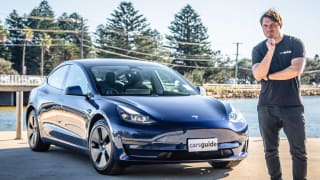When the original Polestar 2 launched it was a stand-out in a much less crowded EV market. An early $60,000 starting price was the norm, and the bar to beat was the entry-level Tesla Model 3.
So much has changed since then. The main issue this new 2024 model faces is it's more expensive, and people keen to hop into their first electric car can now choose the significantly more affordable MG4, BYD Atto 3, or GWM Ora. And at the Polestar 2's performance level, there's also now the choice of the Cupra Born or further discounted Model 3 and its Model Y SUV companion.
No longer able to stand out due to scarcity, the Polestar 2 now has to stand on its own, which is no doubt why a lot of the upgrades for this deeply facelifted version are far more than skin deep and serve to address many of our main complaints about the original version.
The blockbuster news is the range has switched from primarily front-wheel drive to rear-wheel drive, which should have a significant bearing on both driving dynamics and efficiency, as well as upgraded and more powerful motors, with larger batteries for the whole range.

Unfortunately, this also comes with a price-hike of $3500 for the base Standard Range (now from $67,400 before on-road costs and state-specific EV discounts), or $3000 for the Long Range ($74,400) and Long Range Dual Motor ($76,400) variants. It seems reasonable given the significant upgrades, but it does serve to increase the price difference between this car and its closest competitors. However, the whole range still lands well under $100,000 which is not bad for a semi-premium EV proposition.
The Standard Range had important once-optional equipment added, including blind spot monitoring, rear cross-traffic alert, a surround view monitor, and a wireless phone charger.
This adds to its carryover standard equipment list of 19-inch wheels, LED headlights, cloth seat trim with four-way power adjust and heating for the front passengers, an 11.15-inch portrait-oriented multimedia touchscreen running the Android Automotive operating system, Apple CarPlay connectivity, a 12.3-inch digital instrument cluster, keyless entry and start, and dual-zone climate control.

The three option packs remain the same as before, although with a slightly altered set of inclusions.
The Pilot Pack ($3500) now adds adaptive cruise control, upgraded pixel LED headlights with fog lights, and emergency stop assist which can bring the car to a halt when the driver is unresponsive.
The Plus Pack ($6000) adds an energy efficient heat pump, premium harmon kardon audio system, a heated steering wheel, heated rear outboard seats, 'weavetech' seat upholstery, upgraded interior ambient lighting, an upgraded air filter, a panoramic fixed sunroof, upgraded trim for the cargo area, rear tinted windows, a foot sensor for the powered tailgate, and access to the digital key via the phone app.

Finally, the Performance Pack ($9000) continues to only be available on the top-spec Long Range Dual Motor version. It ups power to 350kW via a software tweak, adds 20-inch forged alloy wheels and a Continental SportContact tyre package, as well as Brembo brakes and dual-flow manually adjustable Ohlins dampers in the suspension. It also features a gold theme for the seatbelts, valve caps, and brake calipers.
Individual options include ventilated Nappa leather seat trim (which Polestar says is animal welfare approved) in a 'light ash' colour scheme, a set of 20-inch V-spoke wheels, metallic paint choices, and a folding towbar.
It's no longer one of the cheapest EVs on the market, but I'd argue the price increases are only moderate for a significant upgrade this time around. I'm particularly intrigued by the Standard Range, which now might be the pick (depending on your needs) with its significantly increased battery capacity.




















